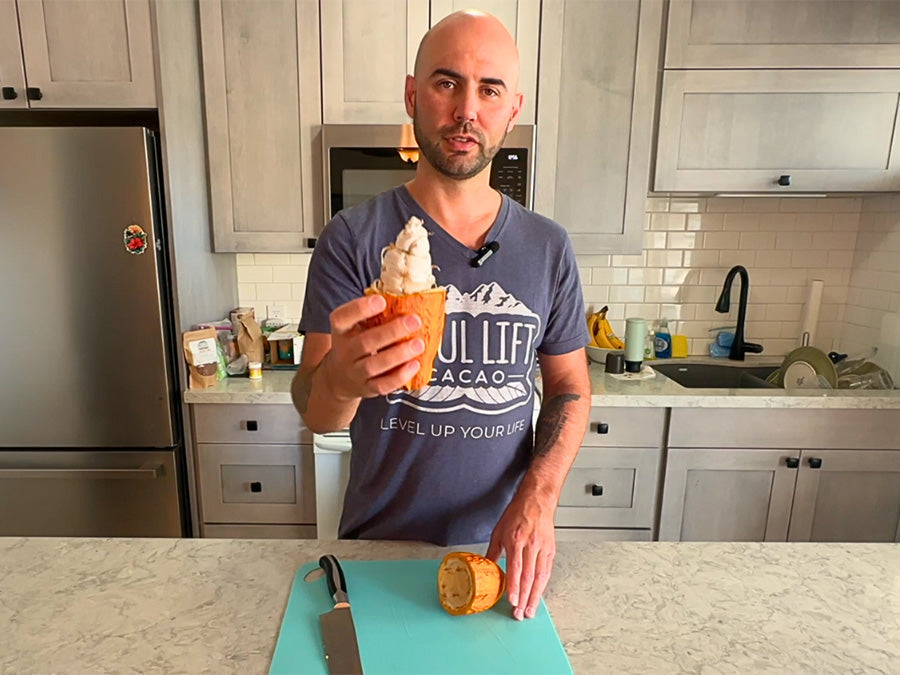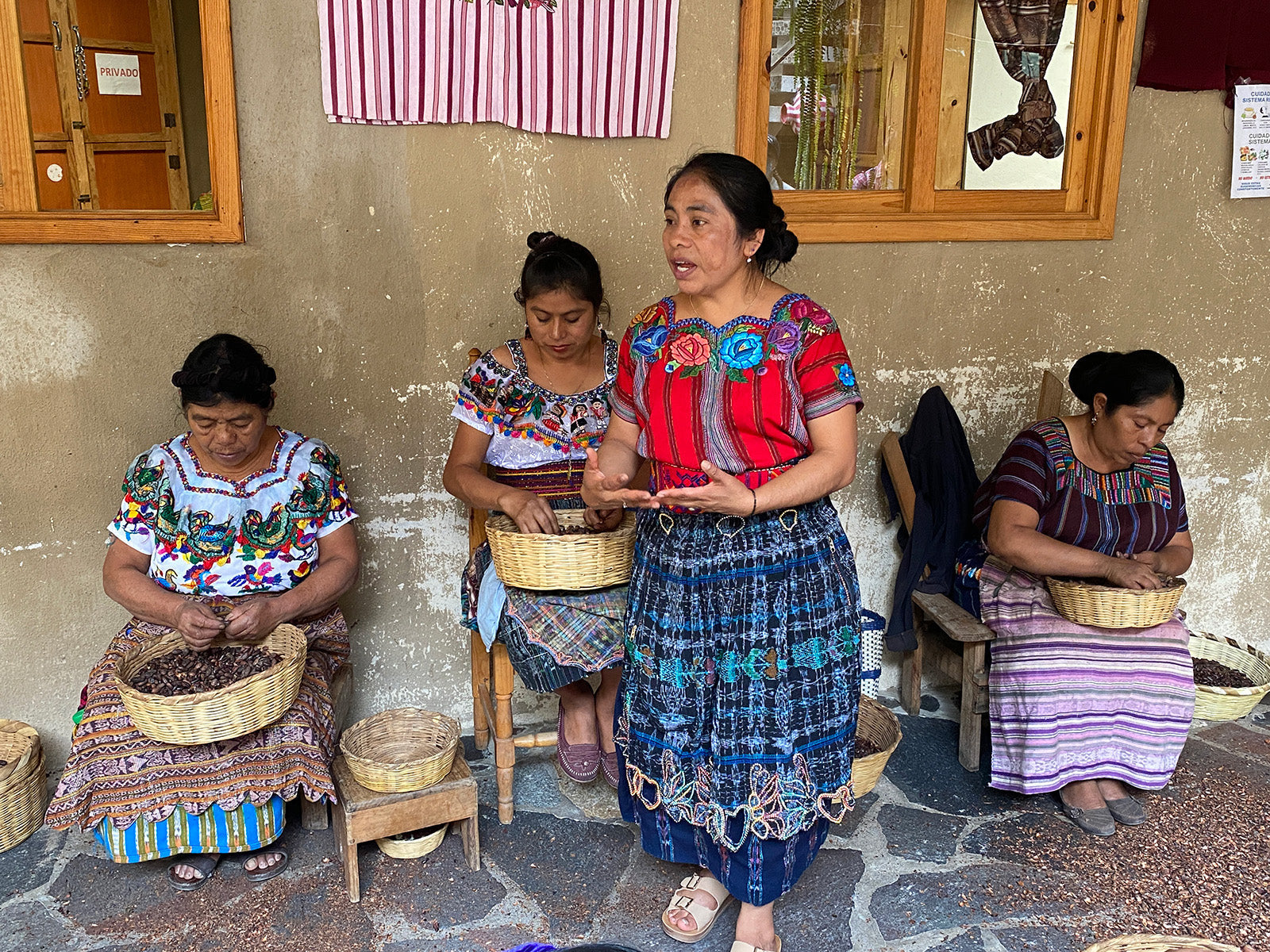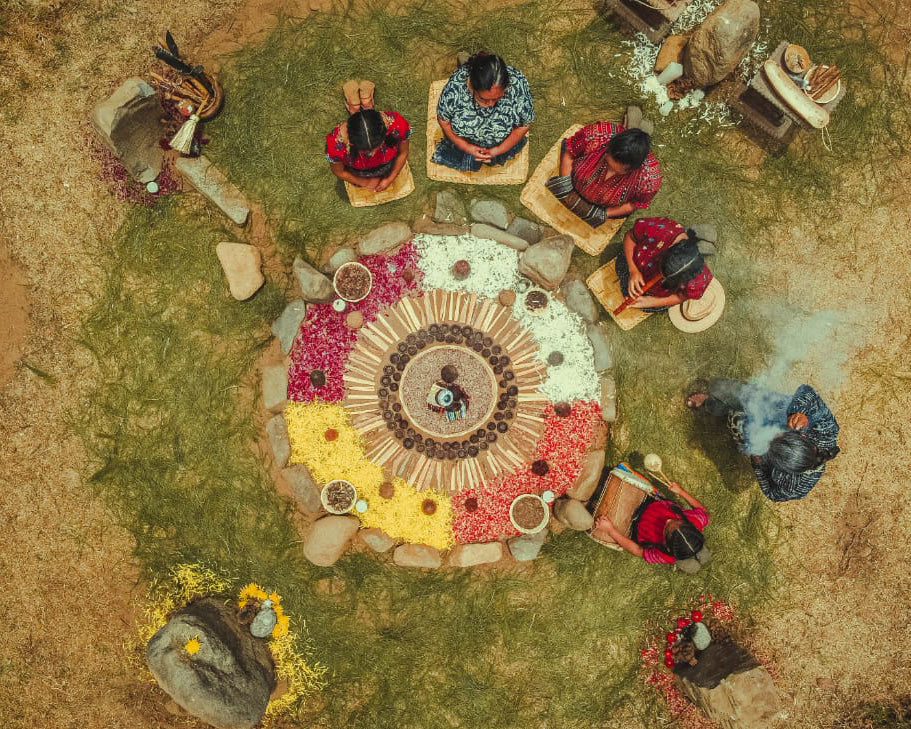Guatemala is a captivating and complex country located in the northern part of Central America.
While it’s a developing nation still recovering from a decades-long civil war in the late 20th Century, it’s currently stable in the context of Latin American politics.
Interest in ceremonial cacao has grown consistently over the last 10-15 years, and many people are traveling to Guatemala to learn more about it in person. That’s because Guatemala is at the heart of the Mayan world, which has had some of the most structured traditions that treat cacao as a sacred medicine for thousands of years.
Guatemala also features incredible nature spots and a living culture – especially in the form of textiles, languages, and artwork – of the Mayan people who call it home.
While Guatemala is actually a relatively small country (about the size of the state of Virginia, or Ohio, for example), even nearby villages can sometimes still have very different traditions, or even speak different Mayan dialects.
Most tourists visit the Western Highlands, the area between Guatemala City and Quetzaltenango (also known as Xela – pronounced “Shay-lah”) that has a high elevation and a comfortable climate. This is where Antigua and Lake Atitlán are located.
There are entire travel books that cover all the amazing things to do in Guatemala. Instead of trying to summarize that here, this article will run through some of the main considerations for fostering a pleasant visit to “the country of the eternal spring,” as it is known by locals.
Before we jump in, we wanted to mention that we lead group cacao tours to Guatemala where we visit cacao farms and collectives, as well as participate in traditional Mayan ceremonies. We take care of all the lodging, ground transportation, and logistics, so you don’t have to worry about it!
We orient participants to all of these points on our tours. But if you’ll be traveling there on your own, here are the six main things to think about when planning a trip to Guatemala:
1) TRANSPORTATION
While it is possible to rent a car in Guatemala, it can be expensive and also a bit unpredictable in a country where a lot of roads have either bumpy pavement or gravel.
Uber service is now available in Guatemala City and Antigua (only about 45 minutes apart when traffic isn’t bad). And this is by far the cheapest and easiest way to get a taxi around the capital. Since Uber drivers are registered and get ratings, it’s one of the safest ways to get around too.
For traveling further, group shuttles usually fit about 8 people and will go to any tourist destination in the country. Depending on how far, the cost might be $20-40 per person. Search TripAdvisor for “Gutemala group shuttle” for recommendations.
The most economic option is to take a “chicken bus” – a decked-out, retired, American school bus. They have the most stops along the way but are by far the most affordable. We once took a ride from Guatemala City to Santiago Atitlan for about $5 USD! Check out thebusschedule.com for times and routes.
The last ground transportation option is to hire a private driver, which is an appealing option for mid-range trips such as between Guatemala City and Lake Atitlan. That specific trip will cost $80-120, but the advantage is that you can control the schedule, how many bathroom stops you make, etc. You can find driver recommendations on the Lake Atitlan Buy Sell Trade group on Facebook.
If you’re hoping to see the famous Tikal ruins in northern Guatemala, or Puerto Barrios near the Atlantic coast, you might want to take a domestic flight from Guatemala City. While short flights in Central America can sometimes be very costly, these are currently somewhat affordable. Round trip tickets from GUA to Puerto Barrios currently go for about $250, but to Flores (the nearest airport to Tikal) they can currently be found for only $100 USD! Flying would save you 8-12 hours in a bus each way, depending on the destination.
2) FOOD & WATER
Overall, Guatemalan cuisine is simple and nutritious. Staples include beans, root vegetables, eggs, cheese, avocados, plantains, and – perhaps most unique to Guatemala – fresh-made tortillas. The tortillas are made from fine-ground cornmeal, so they come out a bit thicker and softer than Mexican tortillas.
Gluten-free travelers can rejoice knowing that gluten is almost non-existent in Guatemalan food, except for when eating at a more modern or commercialized restaurant.
Interestingly, cacao drinks are not currently very common throughout most of Guatemala. Families will often use cacao in their own cooking. However, cafes serving cacao drinks are mainly found in Antigua and at Lake Atitlán. And really, San Marcos la Laguna is the only place with many establishments serving the kind of wood fire-roasted cacao that we carry.
The general rule when eating in Guatemala is: if the place looks clean and they have running water in the bathroom for people to wash hands, then it’s probably fine.
However we don’t recommend eating meat in rural areas, since refrigeration tends to be lacking. Also, only eat fresh vegetables and salads if you know for sure that they’ve been washed in purified water.
Like many Latin American countries, due to infrastructure issues there are parasites in the tap water. One way to avoid exposure is to drink only bottled water, known locally as “agua purificada” or “agua pura.” However, in Guatemala there are more and more “eco filters” that work using gravity and remove any dangerous microbes.
Other water considerations are to brush your teeth only with filtered water, keep your mouth closed while showering, and swim only in lakes or pools that you know are clean. For example at Lake Atitlán, there’s an unfortunate lack of water treatment facilities, meaning that untreated sewage is dumped into the lake. Some people still swim in the lake. And keep in mind that locals who grow up with this microbiome don’t have an issue with the parasites. This is mainly a concern for foreign travelers.
3) TOILET ETIQUETTE
Speaking of sewage, here’s another pretty common thing to remember while traveling in Central America. Due to the use of 2” pipes instead of the 4” ones that are standard in the U.S. and Europe, toilet paper generally can’t be flushed down the toilets in Guatemala.
After using the paper, it goes into a little trash bin next to the toilet.
It’s important to know this so that you don’t clog the toilet system and cause a big inconvenience for the hotel or restaurant.
And it helps to mentally prepare, since it can seem strange at first or like you’re doing something wrong. It’s actually the correct way! :)
4) PHONE & ELECTRONICS
In the 2020s, international cell coverage is becoming a lot more accessible. And we recommend seeing if you can get it through your regular cell provider, since being without cell service while traveling can make things more difficult.
It is possible to get a local SIM card for local calls and mobile data while in Guatemala, and you can usually do this at the airport in Guatemala City. But occasionally there’s a complicated process to get these SIM cards, and then to make an international phone call to friends and family at home would use most of your funds.
Having international cell service through your regular provider means that you can look up restaurants on Google Maps, text a taxi driver over WhatsApp (which EVERYONE in Guatemala uses), and also easily call friends or family back at home.
As for other electronics, we recommend keeping things light. If you depend on your laptop for work or you have a photography hobby, then of course bring the devices you need. But if something isn’t really needed, consider leaving it at home. It will lighten your load and give you one less thing to worry about. Plus there are Internet cafes in pretty much every tourist area where you can pay to use a computer.
5) CRIME PREVENTION
In general the Guatemalan people are warm and welcoming. But let’s face it… crime exists everywhere.
We actually feel safer in Guatemala than in some American cities. However Guatemala is a developing nation with high poverty rates. So even travelers who don’t identify as wealthy when they’re at home, might stand out as targets for theft.
By far the most common crimes are robberies that don’t involve any altercation, for example someone entering a hotel room when it’s empty in order to steal electronics. This is another reason to leave unnecessary devices at home, as well as expensive jewelry and really anything that can’t be replaced.
Like in American cities, it’s a good idea to avoid going around alone, especially if you’re a woman, and even more so at night. Don’t walk around with a mobile phone highly visible, since electronics like that have “street value” that makes them prone to theft.
For certain hikes or day trips it’s advisable to hire a local guide. Just make sure to get one who has been vetted through a personal reference or who has high reviews on a website like TripAdvisor.
The U.S. State Department reports that the areas near the Mexican border close to the Pacific Ocean have drug trafficking activity that makes them less safe. There are also parts of Guatemala City that are not safe to go to. Otherwise, it’s basically recommended to stay in touristy areas and take the usual precautions.
Aside from practical considerations, always trust your intuition about situations and places.
6) MINDFULNESS
Guatemala is a one-of-a-kind country that offers some unforgettable experiences for the well-prepared, intentional traveler.
But it can also be overwhelming at times. Whether it’s the slower ground transportation, noisy fireworks in the villages, stray dogs barking, or something else, the reality is that it’s totally different from the U.S. and other more developed countries.
So our last piece of advice is to look at a trip to Guatemala as a chance to practice mindful awareness. In other words, the whole thing can be like an introspective practice or transformational journey.
When something gets uncomfortable or irritating, we can notice that, take deep breaths, stretch our body, and/or take other steps to get grounded and resourced.
Like any meditative practice, the idea isn’t for things to be perfect; it’s to learn from the imperfections and become more whole as a result.
Seeing how different it is there provides important perspective and begs the question of how we might be able to contribute to the betterment of Guatemala.
This perspective is at the root of our model of sourcing artisanal ceremonial cacao through ethical direct trade.
Our model sends an average of 17x (or 1700%) of the “fair trade” rate back to the source country and promotes more sovereignty for Mayan farmers and artisans.
Visit our online shop to see the products (cacao and other goods) we carry, or learn more about our Guatemalan cacao tours.
Related Posts

Most people never see what comes before a cacao block, or even a drink. And it's a shame, because it can help us appreci
Read More
The price of Heart of the Earth cacao has risen a lot recently. Some factors are the same for all our cacao. Yet this un
Read More
This is the story of how we helped Mayan spiritual guides express how they felt exploited by a non-indigenous company...
Read More





